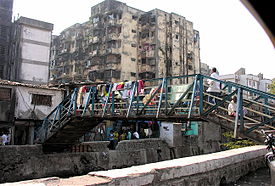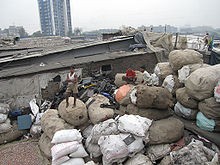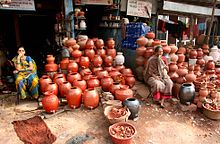- Dharavi
-
For the film, see Dharavi (film).
 Dharavi compared to other large slums in the world. Map according to Mike Davis.
Dharavi compared to other large slums in the world. Map according to Mike Davis.
Dharavi (Portuguese spelling Daravi[1] British Anglicised spelling Darravy, Dorrovy) is a slum and administrative ward, over parts of Sion, Bandra, Kurla and Kalina suburbs of Mumbai, India. It is sandwiched between Mahim in the west and Sion in the east,[2] and spread over an area of 175 hectares, or 0.67 square miles (1.7 km2). In 1986, the population was estimated at 530,225,[3] but modern Dharavi has a population of between 600,000[4] and over 1 million people.[5] Dharavi is one of the largest slums in the world.[5][6][4][7][8] It used to be the largest slum in Mumbai at one time, but as of 2011, there are four slums in Mumbai larger than Dharavi.[9]
In most large cities, the floor space index (FSI) varies from 5 to 15 in the Central Business District (CBD) to about 0.5, or below, in the suburbs. In Mumbai the permitted FSI is uniform and in 1991 was fixed at 1.33. The regulations that restrict the FSI greatly reduce the floor space available for residence and business.[10] In expensive Mumbai, Dharavi provides a cheap alternative where rents were as low as US$4 per month in 2006.[11] Dharavi exports goods around the world.[12] The total (and largely informal) turnover is estimated to be between US$500 million[3] and over US$650 million per year.[11]
Dharavi is Situated between Mumbai's two main suburban railway lines, the Western and Central Railways. To its west are Mahim and Bandra, and to the north lies the Mithi River, which empties into the Arabian Sea through the Mahim Creek. To its south and east are Sion and Matunga. Both its location and poor drainage systems make Dharavi particularly vulnerable to floods during the wet season.
Dharavi covers an area of 535 acres (217 ha).[13]
Contents
History
In the 18th century, Dharavi was an island.[14] In February 1739, Chimnaji Appa attacked Bassein. Before that, he took possession of Dharavi.
The area of present-day Dharavi was predominantly mangrove swamp before the late 19th century, inhabited by Koli fishermen.[15] However, the fishing industry disappeared when the swamp areas filled in. A dam at Sion, adjacent to Dharavi, hastened the process of joining separate islands into one long, tapered mass. Thus began the transformation of the island city of Bombay. In the process, Dharavi's fishing town was deprived of its traditional sustenance, but the newly drained marshes provided space for new communities to move in. Migrants from Gujarat established a potters' colony, and Maharashtrian tanners belonging to the Charmarkar caste migrated to Dharavi and set up the leather tanning industry. Other artisans, like the embroidery workers from Uttar Pradesh, started the ready-made garments trade.[15]
Tamil migrants, including Tamil Muslims, Adidravidars and Nadars started coming into the area in the late 19th century, many of whom worked in nearby tanneries; a large influx came in the 1920s. Bombay's first Tamil school and Dharavi's first school was constructed in 1924. It remained the only school of Dharavi for the next four decades. In 1930s, a single road passed through Dharavi towards the Mahim railway station.[16]
Dharavi's Co-operative Housing Society was formed in the 1960s to uplift the lives of thousands of slum dwellers by the initiative of Shri. M.V. Duraiswamy, a well-known social worker and congress leader of that region. The Dharavi co-operative housing society promoted 338 flats and 97 shops and was named "Dr. Baliga Nagar."
Residents
A majority of the residents of Dharavi belong to the paraiyar caste especially the Adidravidar of the Tamil people, they had also built a Ganesh Temple and "The bombay South Indian Adi-Dravida Mahajana Sangh" which own the piece of land and the areas adjoining the temple.[17] Other castes and tribes are also present. Minorities include Christians, Muslims and Buddhists.
Economy
In addition to the traditional pottery and textile industries in Dharavi,[15] there is an increasingly large recycling industry, processing recyclable waste from other parts of Mumbai. The district has an estimated 5000 businesses[18] and 15,000 single-room factories.[19]
Redevelopment plans
There have been many plans since 1997[20] to redevelop Dharavi like the former slums of Hong Kong such as Tai Hang. In 2004, the cost of redevelopment was estimated to be
 5,000 crore (US$1.01 billion).[21] Companies from around the world have bid to redevelop Dharavi,[13] including Lehman Brothers, Dubai’s Limitless and Singapore’s Capitaland Ltd.[13] In 2010, it is estimated to cost
5,000 crore (US$1.01 billion).[21] Companies from around the world have bid to redevelop Dharavi,[13] including Lehman Brothers, Dubai’s Limitless and Singapore’s Capitaland Ltd.[13] In 2010, it is estimated to cost  15,000 crore (US$3.04 billion) to redevelop.[21]
15,000 crore (US$3.04 billion) to redevelop.[21]The latest urban redevelopment plan proposed for the Dharavi area is managed by American-trained architect Mukesh Mehta.[15] The plan[22] involves the construction of 30,000,000 square feet (2,800,000 m2) of housing, schools, parks and roads to serve the 57,000 families residing in the area, along with 40,000,000 square feet (3,700,000 m2) of residential and commercial space for sale.[23] There has been significant local opposition to the plans, largely because existing residents are due to receive only 225 square feet (20.9 m2) of land each.[15][23] Furthermore, only those families who lived in the area before 2000 are slated for resettlement. Concerns have also been raised by residents who fear that some of their small businesses in the "informal" sector may not be relocated under the redevelopment plan.[24] The government has said that it will only legalize and relocate industries that are not "polluting."
Sanitation issues
Dharavi has severe problems with public health, due to the scarcity of toilet facilities, due in turn to the fact that most housing and 90% of the commercial units in Dharavi are illegal.[25] As of November 2006 there was only one toilet per 1,440 residents in Dharavi.[26] Mahim Creek, a local river, is widely used by local residents for urination and defecation, leading to the spread of contagious diseases.[15] The area also suffers from problems with inadequate drinking water supply.[27]
Guided tours through Dharavi
A few travel operators offer guided tours through Dharavi, showing the industrial and the residential part of Dharavi and explaining about problems and challenges India is facing. These tours give a deeper insight into a slum in general and Dharavi in particular.[28]
Media depiction
- Dharavi has been depicted in a number of Hindi films produced by the Mumbai film industry. These include Salim-Javed films such as Deewaar (1975), Mira Nair's Salaam Bombay! (1988) where several child actors were from the Dharavi slum, Vidhu Vinod Chopra's Parinda (1989), Sudhir Mishra's Dharavi (1991), Ram Gopal Varma's "Indian Gangster Trilogy" (1998–2005) and Sarkar series (2005–2008), Vikram Bhatt's Footpath (2003), Anurag Kashyap's Black Friday (2004) and No Smoking (2007), Madhur Bhandarkar's Traffic Signal (2007), Rajeev Khandelwal's Aamir (2008), and other films based on the Mumbai underworld.
- Dharavi has been depicted in films from other Indian film industries, particularly the Tamil film industry. Several films by Mani Ratnam based on the experiences of Tamil immigrants to Mumbai have depicted the Dharavi slum, including Nayagan (1987) and Bombay (1995).
- Dharavi features prominently in Danny Boyle's 2008 film Slumdog Millionaire, where several of the child actors in the film are from the Dharavi slum. And the super hit movie Mankatha was shot here starring Ajith kumar.
- In Kaminey, the 2009 Hindi movie, starring Shahid Kapoor.
- In the 2009 Swiss/German documentary Dharavi, Slum for Sale of director Lutz Konermann.[29]
- In a programme aired in England in January 2010, Kevin McCloud and Channel 4 aired a two-part series titled Slumming It[30] which centered around Dharavi and its inhabitants.
- The poem Blessing (poem) by Imtiaz Dharker is about Dhavari not having enough water.
See also
References
- ^ D'Cunha, Jose Gerson (1900). "IV The Portuguese Period". The Origins of Bombay (3 ed.). Bombay: Asian Educational Services. pp. 265. ISBN 81-206-0815-1. http://books.google.com/?id=miD5YO05jpUC&dq=the+origins+of+bombay. Retrieved 2009-01-04.
- ^ National Geographic: Dharavi, Mumbai's Shadow City
- ^ a b "Jai Ho Dharavi". Nyenrode Business Universiteit. http://www.nyenrode.nl/businesstopics/europeindia/Pages/%E2%80%9CJaiHo%E2%80%9DDharavi.aspx. Retrieved 2010-03-05.
- ^ a b "Life in Dharavi, Inside Asia's Biggest Slum, by Alex Perry". TIME Asia. 2006-06-19. http://www.time.com/time/asia/covers/501060619/slum.html. Retrieved 2010-03-05.
- ^ a b "Life in a Slum". BBC News. http://news.bbc.co.uk/2/shared/spl/hi/world/06/dharavi_slum/html/dharavi_slum_intro.stm. Retrieved 2010-03-05.
- ^ "The Strange Allure of the Slums". The Economist. http://www.economist.com/surveys/PrinterFriendly.cfm?story_id=9070714. Retrieved 2010-03-05.
- ^ Sharma, Kalpana; "Rediscovering Dharavi: Story From Asia's Largest Slum" (2000) —Penguin Books ISBN 0-14-100023-6
- ^ Dharavi not Asia's largest slum: UNDP report
- ^ Dharavi in Mumbai is no longer Asia's largest slum. The Times of India. Clara Lewis, Jul 6, 2011.
- ^ "FSI Floor space index". http://alain-bertaud.com/AB_Files/AB_Mumbai_FSI_conundrum.pdf.
- ^ a b "Dharavi". BBC. http://news.bbc.co.uk/2/shared/spl/hi/world/06/dharavi_slum/html/dharavi_slum_intro.stm. Retrieved 2010-01-02.
- ^ Ahmed, Zubair (2008-10-20). "Indian slum hit by New York woes". BBC News. http://news.bbc.co.uk/2/hi/business/7676337.stm. Retrieved 2010-05-01.
- ^ a b c http://www.livemint.com/2010/04/23222011/US-firm-exits-Dharavi-project.html?d=1
- ^ "Gazetteers of the Bombay Presidency - Thane". Government of Maharashtra. http://www.maharashtra.gov.in/pdf/gazeetter_reprint/Thane-III/places_Bassein.html. Retrieved 2009-04-03.
- ^ a b c d e f Mark Jacobson (May 2007 issue). "Dharavi Mumbai's Shadow City". National Geographic. http://www7.nationalgeographic.com/ngm/0705/feature3/. Retrieved 2007-04-30.
- ^ Clothey, Fred W. (2006). Ritualizing on the boundaries. Univ of South Carolina Press. p. 91. ISBN 9781570036477. http://books.google.com/?id=uRxAOJWnyEwC&pg=PA91&dq=dharavi+. Retrieved 2009-05-18.
- ^ "Dharavi, by Katia Savchuk & Matias Echanove". Urban Typhoon. http://www.urbantyphoon.com/dharavi.htm. Retrieved 2010-03-05.
- ^ http://www.livemint.com/2010/03/23000503/Harvard-students-get-lessons-o.html?d=1
- ^ Waste not, want not in the £700m slum, The Guardian, 4 March 2007
- ^ http://www.mumbaimirror.com/article/2/2010102220101022015941712cc664adc/Dharavi-makeover-in-limbo-as-CM-stays-indecisive.html
- ^ a b The Times Of India. http://economictimes.indiatimes.com/news/politics/nation/Calls-to-scrap-Dharavi-makeover-gain-ground/articleshow/6363548.cms.
- ^ "Dharavi Redevelopment Project". Slum Rehabilitation Authority. http://www.sra.gov.in/htmlpages/Dharavi.htm. Retrieved 2009-03-02.
- ^ a b Dharavi redevelopment plan is robbing us of space: residents, Wall Street Journal, 5 September 2007
- ^ Vaswani, Karishma (2007-08-30). "Mumbai slum dwellers fight development plan". BBC News. http://news.bbc.co.uk/2/hi/business/6970800.stm. Retrieved 2009-03-02.
- ^ http://www.worldpress.org/Asia/2831.cfm
- ^ Toilets Underused to Fight Disease, U.N. Study Finds, New York Times, 10 November 2006
- ^ In a city like Mumbai, Our Planet
- ^ The Times: Mumbai slum tour: why you should see Dharavi http://www.timesonline.co.uk/tol/travel/destinations/india/article7124205.ece
- ^ Dharavi, Slum for Sale at the Internet Movie Database
- ^ "Slumming It: Dharavi". Channel 4. http://www.channel4.com/4homes/on-tv/kevin-mccloud-slumming-it/kevin-mccloud-slumming-it-episode-two-10-01-06_p_1.html. Retrieved 2009-04-08.
Further reading
- Ranjit Naik
- Sharma, Kalpana; "Rediscovering Dharavi: Story From Asia's Largest Slum" (2000) —Penguin Books ISBN 0-14-100023-6
- "Life in a Slum" - BBC News
- Location of Dharavi - Google Maps
- Mark Jacobson (May 2007 issue). "Dharavi Mumbai's Shadow City". National Geographic. http://www7.nationalgeographic.com/ngm/0705/feature3/. Retrieved 2007-04-30.
- "Urban poverty in India: A flourishing slum" and "Recycling: A soul-searching business", The Economist, 19 December 2007
- "Women Have Done It Again: A featured article in CrossOver India Magazine"
- Everyone Wants a Slice of the Dharavi Pie - Live Mint
External links
- dharavi.org: A participatory site on Dharavi
- Prakash M Apte; "Dharavi:India's Model Slum" www.planetizen.com/node/35269
Mumbai metropolitan area South Mumbai
NeigbourhoodsColaba · Parel · Elephanta Island · Fort · Dadar · Mahim · Mahalaxmi · Carmichael Road · Altamount Road · Kemps Corner · Marine Lines · Churchgate · Charni Road · Prabhadevi · Nariman Point · Navy Nagar · Tardeo · Girgaon · Kalbadevi · Worli · Cuffe Parade · Malabar Hill · Byculla · Chinchpokli · Wadala · Walkeshwar · Kala Ghoda · Kotachiwadi · Elphinstone Road · Sewri · Dadabhai Naoroji Road · Apollo Bunder · MazagaonEast Mumbai Suburban
NeighbourhoodsWest Mumbai Suburban
NeighbourhoodsAndheri · Bandra · Goregaon · Malad · Juhu · Kandivali · Borivali · Santacruz · Vile Parle · Dahisar · Versova · Kanheri Caves · Jogeshwari · Aarey Milk Colony · MarolNavi Mumbai
NeighbourhoodsVashi · Nerul-Seawoods · Ghansoli · Kopar Khairane · Sanpada · Turbhe · Belapur · Digha · Kharghar · Rabale · New Panvel · Airoli · Juinagar · Mansarovar (Navi Mumbai) · Kalamboli · Khandeshwar · KamotheThane City
NeighbourhoodsMira-Bhayandar Kalyan-Dombivali Vasai-Virar Bhiwandi-Nizampur Bhiwandi · NizampurUlhasnagar Municipal Councils Coordinates: 19°02′38.4″N 72°51′23.0″E / 19.044°N 72.85639°E
Categories:- Neighbourhoods in Mumbai
- Shanty towns
- Slums in India
Wikimedia Foundation. 2010.




